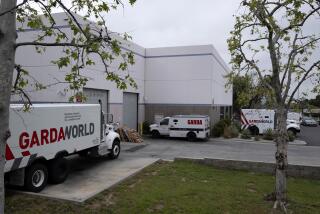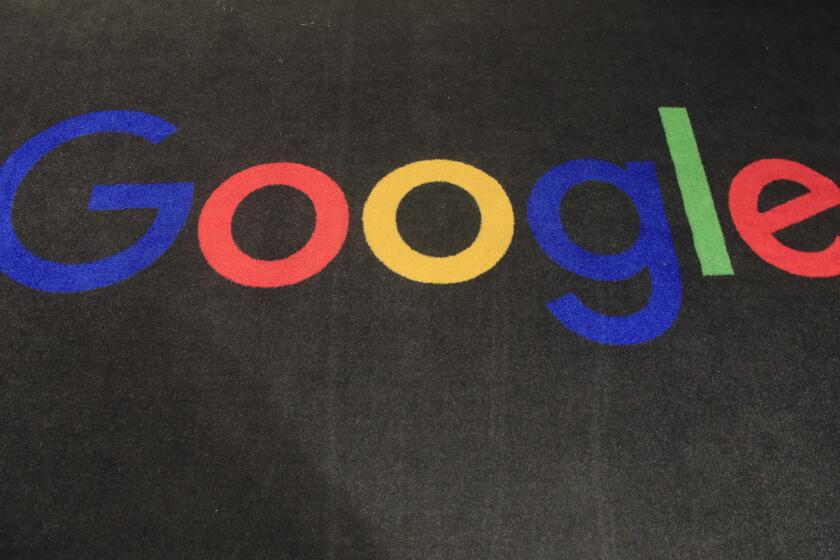You’ve saved 10 years’ worth of U.S. legal tender in that Arrowhead jug sitting in the corner of the bedroom, but when you take it to the bank, those pennies are treated like : ‘Dirty Money’
- Share via
George Costanza, a neurotic character on NBC’s “Seinfeld,” went to a bank in one episode to get greenbacks for all the pennies, nickels, dimes and quarters he had saved.
The teller told him that he would have to roll up all of his coins before the bank would take it.
“What? Am I supposed to quit my job?” George shot back.
This sitcom joke mirrors the frustration for just about anyone who collects change--and lots of it--in bowls, piggy banks and jars, whether it be for a rainy day, the children’s education or just a trip to Vegas.
Problem is, it’s tough to get rid of the coins. Faced with rising labor costs, many banks have stopped using their automated machines to count change for their customers.
Instead, most banks supply customers with paper rolls to be filled at home, after writing account numbers on each. And even after hours of work, customers may face additional fees from some financial institutions--a charge for verifying that the number of coins in each roll is correct.
“No one will count it for you,” said Rob Thaler, sales manager for KIOZ-FM in San Diego, who accumulated four years’ worth of change. “I put it in bags, anything strong enough. It got to the point where I was thinking of renting a coin-counting machine.”
The pile of coins--eventually more than $300 worth--included some change Thaler had collected before he moved to Southern California from New York in 1989.
And people without a bank account may be out of luck altogether.
“The days of piggy-bank saving youngsters being able to go into a bank and crack open their savings are pretty much gone,” said Bob Sturgill, district service manager for Brandt Money Processing Systems in Costa Mesa, which manufactures counting and sorting machines for banks, vending machine firms and laundries. Brandt also wraps coins for businesses and individuals, for a fee.
Banks that once offered coin counting found the state-of-the-art machines both expensive to buy--each counter running anywhere from $1,000 to $8,000--and maintain. Some smaller banks don’t even own counting machines and instead pay a service that has the equipment.
“I just spent a whole evening rolling coins,” said Nancy Badely, a spokeswoman for the California Bankers Assn. in Sacramento. “It added up to about $90. . . . But it just makes sense. For banks, it would just be a (money-) losing task. It takes too much time and labor.”
Among the exceptions is the Bank of Yorba Linda, a community bank. It has held onto its coin sorter as a service to customers.
“We’ve had people come in and open an account just to get their coins counted,” said Jenice Wilkinson, the bank’s vault teller. “Banks even refer inquiries to us because they know we have this service.”
About two years ago, the bank started charging 5% of the total to cover the bank’s cost of processing the coins. It also costs money to maintain the sorter, which gets jammed with keys and paper clips that customers fail to remove from their coin savings.
Frustrated coin savers often call the Federal Reserve Bank branch in Los Angeles. But it also has strict guidelines on what it will take.
“It was a service the banks just used to offer,” said Sandra Conlan, a spokeswoman for the branch. “Now we get calls from people who are a little panicky because nobody will do this. They don’t know what to do with Arrowhead (five-gallon water) bottles full of coins. But we’re not in the business of wrapping coins for individuals or businesses.”
The reason: The Federal Reserve requires coins in official cloth bags, all counted with the proper paperwork. Even then, the branch doesn’t accept people just off the street for security reasons. Usually, it is the banks that have coins delivered to the Fed branch.
“You’ll have people who have saved 10 years’ worth of coins, then they want some one to wrap and sort them all for free,” Conlan said. “They don’t realize how long that takes.” By one estimate, it takes about five to 10 minutes to wrap one roll of 50 pennies.
According to a Wells Fargo spokeswoman, the move in the early 1980s to more centralized, more efficient banking services eliminated counting machines in most branches. Although bank branches still handle the same functions--signing a loan, starting a checking account--the processing of these transactions is now done at a central location.
“We will accept coins, but we prefer them rolled,” said Kathleen Shilkret, at Wells Fargo, which has 56 branches in Orange County.
The same is true at Union Bank.
“We do count them later and then verify them, but we prefer that they be wrapped,” said spokesman David Tockman. Even more, he said, counting machines create a noisy racket at a branch.
First Interstate Bank, with 34 branches in Orange County, will take coins, but transfers them to a central location, either in Los Angeles or San Diego, said Leslie Charlesworth, vice president and area customer service manager in Santa Fe Springs.
“If they have collected over two or three years, it’s no big deal to count them,” she said. “It happens once in a while. But often the branch manager will ask them to roll it up.”
But not every large bank hands its customers paper rolls. Although leaving it up to individual branch managers, some Bank of America locations will count coins for customers--within reason. And for customers with a load of change, the bank branch might not even want it rolled.
“It’s less expensive to bring in a bag than a roll,” said Julie Jasper, a spokeswoman for Bank of America, which has 84 branches in Orange County. “There’s more labor involved in cracking open a roll.”
Even then, Jasper said, there are limits.
“They can abuse a goodwill thing,” she said. “If it’s just one piggy bank, we’ll be more than happy to credit it for some greenbacks. But if it is a customer who has 50,000 piggy banks and starts to bring them in every day, then that is when a branch manager will start to say, ‘No way.’ ”
Other financial institutions even charge for taking rolled coins. Fullerton Savings, for example, several years ago began charging 1% on the worth of rolled coins totaling more than $20. A few of their branches still have coin-counting machines that perform the task.
“We are not a commercial bank, so we don’t have the access to the Federal Reserve,” said Richard Kusserow, vice president of the S&L.; Fullerton Savings must take the coins it receives, put them in bags and transfer the shipment to First Interstate Bank, which then takes them to the Federal Reserve.
“We just want to cover the cost of shipping it,” he said. “Even then, (the 1% charge) probably doesn’t cover our cost. It probably costs us $5 to $6 per bag.”
It not only seems outrageous to be charged by a bank to take your coins in an even exchange, some coin experts question its legality. The Legal Tender Act of 1933 gave unlimited legal tender to all coins. Legal tender is defined as money that may be legally offered in payment of a debt and that a creditor must accept.
John Kleeberg, the assistant curator for the American Numismatic Society in New York, says, “It’s just a habit of banks offering fewer and fewer services.” The fees haven’t been challenged, however, because the cost of suing would be so much greater than simply paying the fees. “Coins are legal tender, and banks have to take them. If I bring in 1,000 quarters, they just have to deal with it because of the way the (laws) governing legal tender are written.”
Not so, according to the Federal Reserve. Although a spokesman for its Washington office didn’t cite a particular statute, banks have done it for years.
“There’s no laws or regulations that require banks to accept it or not accept it,” said Bob Moore, a spokesman for the Federal Reserve Bank in Washington. “It’s a business decision.”
Companies that deal in large volumes of change--vending machine companies, transit agencies, arcades and coin-operated laundries--manage to get by on their own. Many simply take the charge of buying a counting machine or are charged the cost of counting through their contracts with a bank.
Numerous companies in Southern California are involved in counting, sorting and wrapping coins for coin-dependent businesses, but there are only a handful of places where a member of the general public can walk in and get paper money for pennies, dimes and nickels. And those you find will make you pay for it: Customers are charged anywhere between 2% to 15%, depending on the number of coins processed.
Among the biggest operations is the Los Angeles Federal Coin Wrapping & Processing Center, started a counting service for the public about 18 months ago.
“We had so many calls from the general public,” said company President Jesse Ash, a former Federal Reserve Bank executive who co-owns the operation with John Williams and former Los Angeles Rams tight end David Hill. “We do it almost at cost, but we do it for anyone.”
Although its services--including vault storage, wrapping and counting--are performed mostly for businesses and agencies, including the Orange County Transit District, the center’s operation for the public attracts about a dozen customers per day.
“We felt there was such a need,” he said. For example, a roll of 50 pennies can take about five to 10 minutes to do manually. His machines can wrap 32 rolls each minute. The charge: 8 to 10 cents per wrap. Customers also have to have a minimum of $25 in change.
In San Diego, financial institutions that don’t count change refer customers to Balboa Coin Counter, which charges from 2.61% for amounts in excess of $15,000 to 12% for less than $150.
About 20 people a week come to Balboa Coin’s El Cajon office. In December, a Navy serviceman came from Ontario with a load and used the $800 to buy Christmas presents.
“Some people will say, ‘I’ll just go to Las Vegas to get them counted,” said owner Jack Fisher. “But it takes a strong person. Fifty dollars in pennies weighs about 37 pounds.”
Fisher defends his fees, pointing to check-cashing services that charge up to 25% to take a check. “Highway robbery,” he said.
Like Brandt Systems, Balboa’s primary business is manufacturing automatic change counters. The San Diego company just about breaks even on its change-counting service, which it started about three years ago, Fisher said. He even gives frequent customers cloth bags to store their change in because a customer’s water bottle once shattered en route. Balboa was the only place KIOZ’s Thaler could find to count his stash of coins.
Fisher said he is considering opening branches, sort of a change bank.
“It has become a problem,” he said. “Banks are trying to do away with the service, yet they don’t want an angry customer.”
In Orange County, Brandt Systems will count coins by appointment--also for a fee. But news about that service is mainly spread by word of mouth and doesn’t generate a whole lot of revenue.
“When they get to us, they are so relaxed, so relieved to have found this,” said Sturgill of Brandt Systems. “But I don’t know how much of a market there is for this. If needed, we might be willing to do this on a larger scale.”
According to the U.S. Mint, the demand is there. An informal survey conducted in the mid-1980s showed that the average household had 1,000 pennies, the least used but most collected type of currency.
This hoarding of coins can cost the government money because the U.S. Mint has to make up for the lost change not in circulation.
Congress explored eliminating the penny several years ago, but the U.S. General Accounting Office concluded in 1990 that its value still exceeded the cost of producing it.
Gold ‘N Coins in La Habra, which has counted coins for the general public for almost 10 years, advertises in the Yellow Pages. The rare coin and jewelry shop counts up several hundred coins a week. The currency is then deposited in First American Bank in Rosemead if requested, which transfers it to the Federal Reserve Bank.
“Some people are just too cheap and want to spend days counting and wrapping it,” said Les DeVito, co-owner of the store. “It’s all that time lost.”
Like other businesses, Gold ‘N Coins said it doesn’t turn a profit on the service. “But it gets people in the door,” DeVito said, drumming up customers for his primary business of coin and jewelry sales.
Most customers, he said, are relieved to have found a place to get rid of their jugs full of coins. One of his first customers brought in 750,000 pennies--that’s $7,500. The charge for pennies is $15 for every $100 counted.
Sound expensive? Well, DeVito has a word of advice: “Just don’t let the change collect,” he said. “Spend it.”
A sentiment echoed by Jim Benfield, president of the Coin Coalition in Washington.
“Pretty soon it will cost more to make the penny than what it is worth.”
In Circulation
According to the U.S. Mint, there are about 173 billion coins in circulation; pennies are the most abundant.
*
Denomination No. in circulation Percentage Dollar value Pennies 129 billion 74.8% $1.3 billion Nickels 11.5 billion 6.7% $575 million Dimes 16.4 billion 9.5% $1.6 billion Quarters 15.6 billion 9.0 $3.9 billion
*Who receives the most coins? * Phone companies * Vending and laundry machine operators * Arcades * Transportation districts Coin Facts * The average home has about 1,000 pennies around the house. * Four in 10 adults and six in 10 children save coins. * Quarters are the most widely used, half dollars the least. * Coins last about 30 years; dollar bills about 18 months. * GTE processes and ships 2.7 million pounds annually. *
Source: U.S. Mint; Epcot Center; American Numismatic Society; Researched by DALLAS M. JACKSON and TED JOHNSON / Los Angeles Times
More to Read
Inside the business of entertainment
The Wide Shot brings you news, analysis and insights on everything from streaming wars to production — and what it all means for the future.
You may occasionally receive promotional content from the Los Angeles Times.










